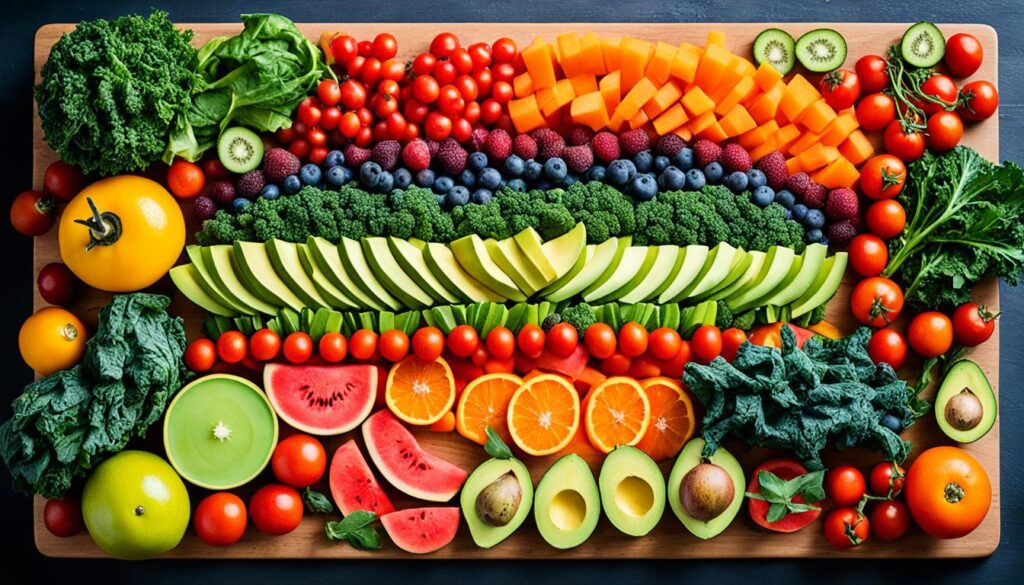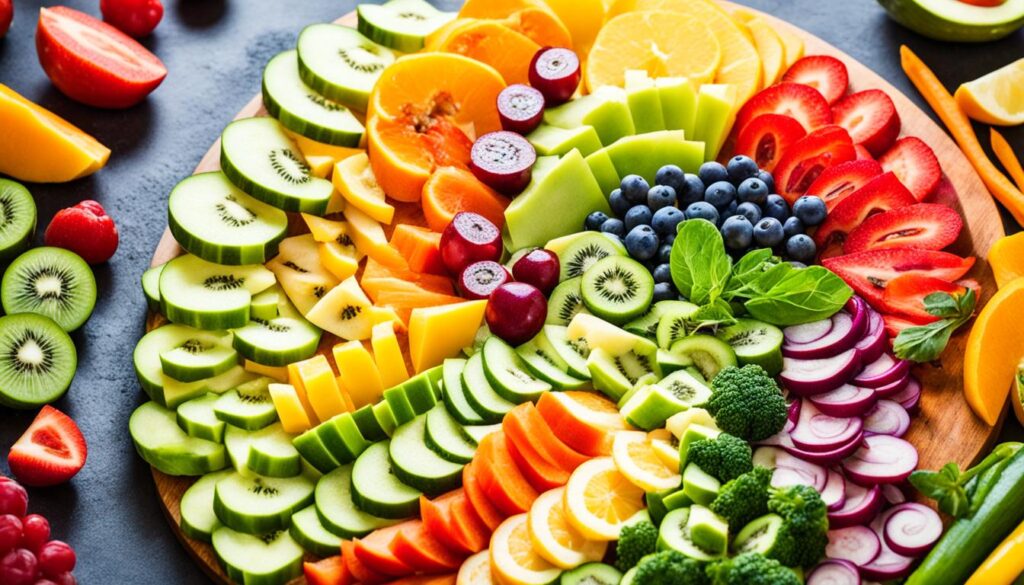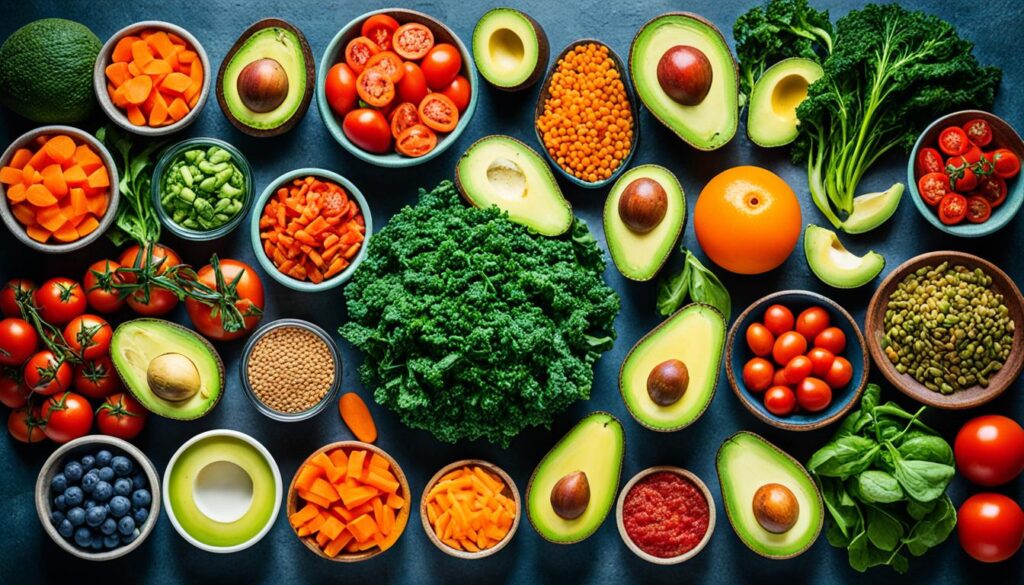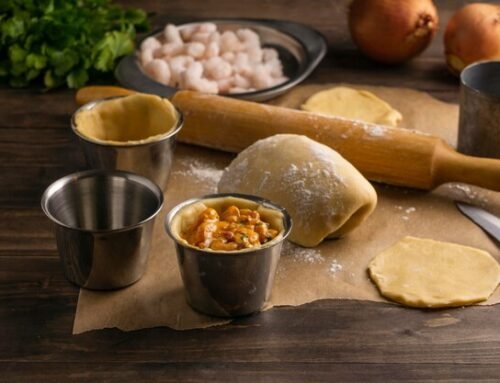Cooking with fire changed human history, making us the top species on Earth. It made nutrients easier to get, so our ancestors could eat less and chew less. But, some say raw food diets keep foods full of nutrients and enzymes. Others believe cooked foods give us more antioxidants and minerals.
This article will show you how to make tasty and healthy raw food meals without cooking. It’s perfect for both raw food lovers and those wanting to eat more uncooked recipes. You’ll learn how to make no-cook meals that are both delicious and nutritious.
Key Takeaways : Raw Food Recipes
- Cooking with fire has been a game-changer for human evolution, transforming us from subsistence animals to the dominant species on the planet.
- The raw food diet debate challenges the merits of cooking, with advocates claiming that it strips foods of vital nutrients and enzymes.
- This article will explore the world of raw food recipes, guiding you through the process of preparing flavorful and healthy raw food meals without the need for cooking.
- Whether you’re a seasoned raw food enthusiast or simply looking to incorporate more uncooked recipes into your diet, this guide will provide you with the knowledge and tools to create delicious and nutritious no-cook meals.
- The article will cover the benefits of incorporating raw foods into your diet, common ingredients used in raw food recipes, and various preparation techniques.
Introduction to Raw Food Diets
Raw food diets have become more popular, leading to debates on their benefits and drawbacks. It’s key to look into how cooking has evolved and the views on raw versus cooked foods.
The Evolution of Cooking and Raw Food Debates
Anthropologists say cooking changed human evolution by making nutrients easier to get and cutting down on food gathering and chewing time. But, raw food fans believe cooking takes away important nutrients and enzymes, hurting the health benefits of these foods.
Some experts argue that cooked foods have more antioxidants and minerals, making them easier for our bodies to use. The debate on raw vs cooked foods keeps going, with strong points from both sides.
Benefits of Incorporating Raw Foods into Your Diet
Adding more raw foods to your diet has many benefits. They are full of fiber and water, helping with weight control and mental health. They also give you a mix of nutrients that might be best in their natural state.
“Eating a diet rich in raw fruits and vegetables can provide a wealth of vitamins, minerals, and antioxidants that may not be as readily available in cooked or processed foods.”
Looking into the history and views on raw food diets helps people make better choices about adding these foods to their diet and lifestyle.
What Are Raw Food Recipes?

Raw food recipes use only uncooked, unprocessed, and unheated ingredients. They have become popular for those wanting healthier, natural diets. But what makes an ingredient “raw,” and which foods should be avoided raw?
Ingredients Commonly Used in Raw Food Recipes
Raw food cuisine is built on fresh, whole foods that stay under 118°F (48°C). Common ingredients include:
- Leafy greens (spinach, kale, lettuce, etc.)
- Vegetables (carrots, zucchini, bell peppers, etc.)
- Fruits (berries, citrus, stone fruits, etc.)
- Sprouts
- Nuts and seeds
- Nut and seed butters
- Sprouted grains and legumes
- Dried fruit
- Homemade nut milks
- Fermented foods (raw sauerkraut, kimchi, etc.)
Foods to Avoid Eating Raw
Many whole foods are safe and good raw. But some need cooking to remove toxins or bacteria. Foods to avoid raw include:
- Mushrooms
- Kidney beans
- Potatoes
These foods can be harmful if eaten raw. Always cook them before eating.
Raw Food Recipes: Preparation Techniques

Creating delicious raw food meals is more than just throwing together a salad or fruit plate. Raw food lovers have learned many new ways to make ingredients taste great and packed with nutrients. Techniques like soaking, sprouting, spiralizing, and dehydrating can bring out the best in raw foods.
Soaking, Sprouting, and Fermenting
Soaking, sprouting, and fermenting can make raw grains, seeds, and beans tastier and easier to digest. Soaking softens these ingredients and unlocks their nutrients. Sprouting changes the food’s chemical makeup, boosting its nutrition and making it easier to digest.
Fermenting is another way to prepare raw ingredients. It makes food taste better and adds probiotics, which are great for health.
Spiralizing and Dehydrating
Spiralizing turns vegetables into long, noodle-like strands. This lets you make pasta-like dishes without cooking. Dehydrating, with a dehydrator or in the oven, removes moisture from ingredients. This concentrates their flavors and keeps their nutrients.
Learning these raw food techniques opens up a world of tasty, healthy meals without traditional cooking. Try these methods to make vibrant, nutrient-rich raw dishes that are sure to please.
| Technique | Description | Benefits |
|---|---|---|
| Soaking | Submerging grains, seeds, and beans in water to soften their textures and unlock their nutrients. | Improved digestibility, enhanced nutrient absorption, and softer textures. |
| Sprouting | Allowing grains, seeds, and beans to germinate, which changes their chemical structure. | Increased nutrient content, improved digestibility, and a more vibrant flavor profile. |
| Fermenting | Using beneficial bacteria to transform the flavor and nutritional profile of raw ingredients. | Introduction of probiotics, enhanced flavor, and improved digestibility. |
| Spiralizing | Transforming vegetables into long, noodle-like strands, creating a pasta-like texture without cooking. | Versatile ingredient for raw food dishes, nutrient-dense, and visually appealing. |
| Dehydrating | Removing moisture from raw ingredients, either with a dehydrator or in the oven, to concentrate flavors and preserve nutrients. | Concentrated flavors, preserved nutrient content, and extended shelf life. |
Raw Food Recipes for Beginners

Starting with raw food recipes is exciting and rewarding, especially for beginners. It’s a great way to add more raw foods to your diet or try a raw food lifestyle. There are many simple and tasty options to choose from.
Simple and Satisfying Raw Food Recipe Ideas
Beginners should start with easy dishes that highlight fresh ingredients’ natural flavors. Great options include:
- Crunchy veggie salads with a creamy avocado-based dressing
- Refreshing fruit smoothies blended with nut butters and superfood powders
- Nourishing kale or spinach salads topped with raw nuts and seeds
- Vibrant raw vegetable “noodle” dishes made with a spiralizer
Focus on quick, satisfying meals that don’t need soaking or dehydrating. These meals will leave you feeling energized and happy.
Tips for Stocking Your Pantry and Meal Planning
Having a well-stocked pantry with versatile ingredients is key to a successful raw food journey. Essential raw food pantry staples include:
- Flax seeds, chia seeds, and hemp seeds
- Nutritional yeast for a savory, cheesy flavor
- Dates, nuts, and nut butters for natural sweetness and healthy fats
- Leafy greens like spinach, kale, and romaine lettuce
When planning meals, read recipes carefully and make sure you have all the ingredients and time needed. This ensures you can make easy raw food meals that taste great and are good for you.
Also Read : Delicious Banana Split Flavors You Never Tried Before
Conclusion
As we wrap up our look at raw food recipes, it’s clear they offer many benefits. Eating raw foods means you get more nutrients and can feel better overall. It’s all about eating foods that haven’t been cooked.
We’ve explored the history of cooking and the debate between raw and cooked foods. We’ve seen the wide variety of ingredients used in raw recipes. We also learned how to prepare them right, like soaking, sprouting, and dehydrating.
If you’re thinking about trying a raw food diet, you’re in luck. We’ve shared easy and tasty recipe ideas to get you started. With the right tools and ingredients, you can make delicious, healthy meals at home.
FAQs
Q. What is the history and debate around cooking and raw food?
Cooking with fire helped humans evolve from being just another animal to becoming the top species. It made food easier to digest, letting humans spend less time finding and chewing tough plants. Now, people argue about raw vs cooked food. Raw food fans say cooking takes away nutrients and enzymes. But, others believe cooked foods are better because they offer more antioxidants and minerals.
Q. What are the benefits of incorporating raw foods into your diet?
Eating more raw foods can add balance and variety to your diet. They are full of fiber and water, which can help with weight loss and improve mental health.
Q. What are the common ingredients used in raw food recipes?
Raw food recipes often include leafy greens, fruits, vegetables, sprouts, nuts, seeds, and more. You’ll also find nut and seed butters, sprouted grains, dried fruit, homemade nut milk, and fermented foods.
Q. Are there any foods that should not be eaten raw?
Yes, some foods shouldn’t be eaten raw. Mushrooms, kidney beans, and potatoes can have toxins or bacteria that cooking gets rid of.
Q. What are some common raw food preparation techniques?
Soaking, sprouting, and fermenting can make grains and seeds tastier without cooking. Sprouting changes the food’s chemical makeup, making it easier to digest. Spiralizing turns veggies into pasta-like strands, and dehydrating uses a dehydrator or the oven to dry foods.
Q. What are some tips for raw food beginners?
Start with simple things like salads and fresh fruit in your meals. Then, try more complex recipes. Pick dishes that don’t need a lot of soaking or dehydrating. Use ingredients like dates, nuts, and cocoa powder for easy recipes.
Stock up on raw food pantry items like flax seeds, chia seeds, nutritional yeast, and spinach. Always read recipes carefully before starting to make sure you have everything you need and enough time.
Source Links
- https://foodrevolution.org/blog/raw-food-recipes-vegan-no-cook/
- https://www.therawtarian.com/raw-food-recipes-beginners
- https://foolproofliving.com/category/special-diet/raw-food/








Leave A Comment